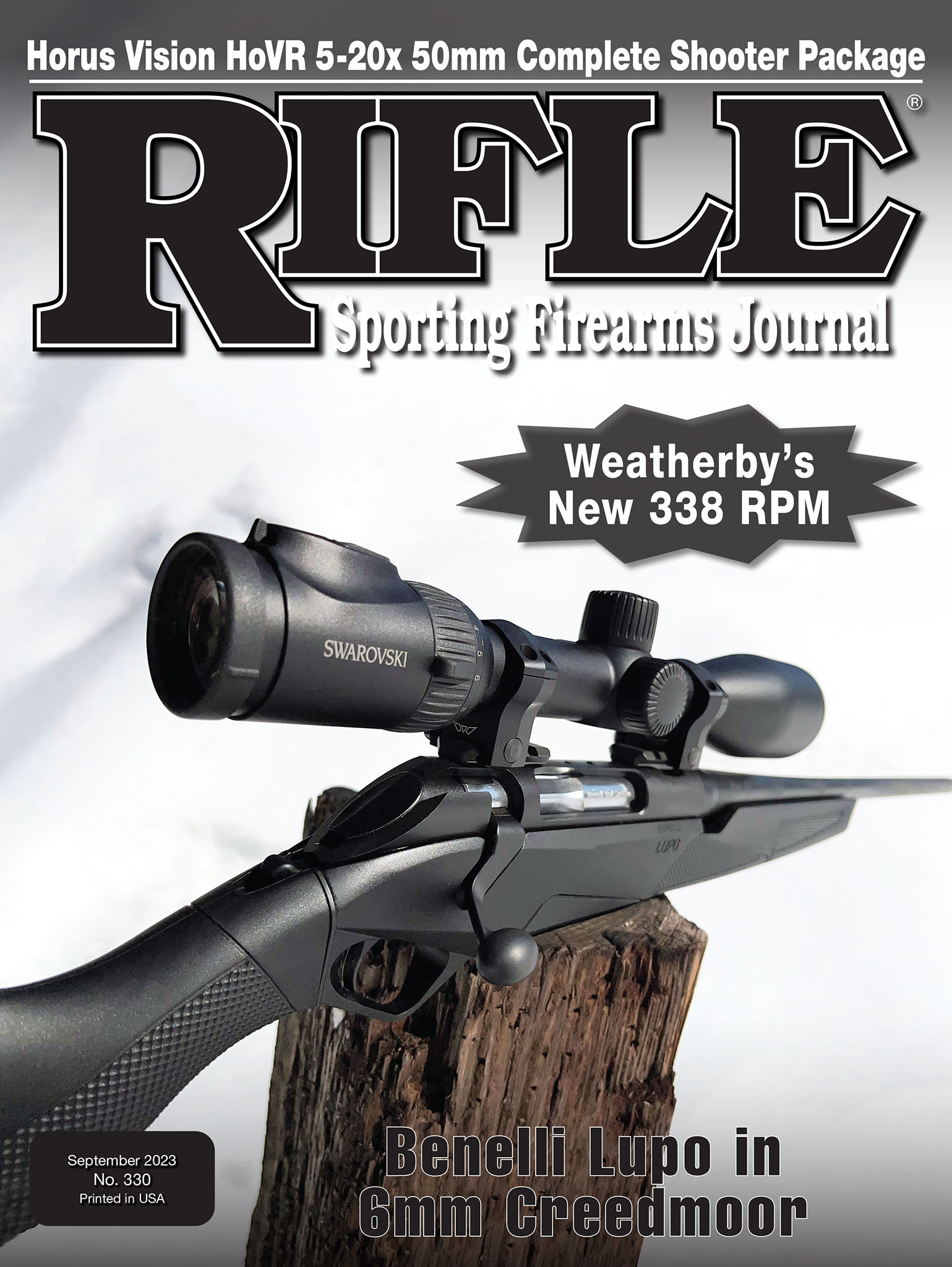Weatherby’s New 338 RPM
A Modern Big-Game Cartridge
feature By: Brian Pearce | September, 23

The history of Weatherby rifles and cartridges dates back to the 1940s when founder Roy Weatherby (1910-1988) began experimenting with high-velocity wildcat cartridges that were based on the belted 375/300 H&H case and soon began offering quality custom rifles for his proprietary ammunition. By the late 1950s, he designed his famous Mark V rifle, which was first built in the U.S., but manufacturing was soon moved to Germany, then to Japan, but it is now being produced in the Weatherby facility located in Sheridan, Wyoming.

Weatherby’s fame and influence within the firearms industry has been significant. During the era that Roy Weatherby was actively designing cartridges for commercial sales, the primary parent case was the 375 belted magnum (with the 224, 30-378, 338-378, 378, 416 and 460 being exceptions, but they were nonetheless belted). Weatherby was not alone, as Winchester, Remington and others likewise used the same case to create new magnum cartridges such as the 300 Winchester Magnum, 7mm Remington Magnum and many others. During this era, the belted magnum case was the logical choice, as it was readily available and offered increased powder capacity. However, modern magnum cartridges featured enough of a shoulder that the belt was not necessary for positive headspace control, but again this case was really the only choice. But times have changed, as we now have magnum capacity beltless cases readily available that are influenced by the 404 Jeffery case (but are indeed different). Examples include the 300 Remington Ultra Magnum case and the 300 Winchester Short Magnum case that are different from each other, while the 375 Ruger case is unique to itself and not based on any other case.

Roy’s grandson, Adam Weatherby, now stands at the helm of the company. I have known Adam for more than 25 years and he is a dedicated rifleman, hunter, father, husband and a very capable leader and businessman. Under his leadership, Weatherby’s operations have been moved from California to the gun-manufacturing-friendly state of Wyoming, which was no small task. As a result, many new rifles have been introduced that are trendy with modern shooters.
In 2015, while on a hunting trip with Adam, I expressed the need for a completely modern, beltless, 6.5-caliber hunting cartridge that would offer performance increases over the 6.5 Creedmoor, but still retain respectable barrel life, efficiency and offer top accuracy. (Note: This was before the introduction of the 6.5 PRC.) Adam and other staff members took considerable interest in my comments and we discussed the idea at length, including ballistics and more. At that time, the company had already finalized the 6.5-300 Weatherby Magnum cartridge and was preparing to announce it in 2016. Then, in 2019, they unveiled the 6.5 Weatherby Rebated Precision Magnum (RPM) that offered more or less the type of ballistic performance that I originally wanted in a hunting cartridge and actually outran the notable 264 Winchester Magnum, but with many additional advantages. It is modern in every respect, as it is based on the 284 Winchester case, but stretched to a longer length of 2.570 inches and has an overall cartridge length of 3.340 inches, which is the same as the 30-06.

For those that may not be familiar with the 284 case, it was innovative when it was introduced in 1963, and it was technically a short magnum long before that concept really caught on with U.S. shooters. It had a head diameter of .500 inch, which is not much smaller than the case diameter of the belted magnum case when measured just forward of the belt (industry specified around .512 inch). But it featured a rebated rim that was .473 inch, which is the same diameter as the 30-06 case. This unique combination resulted in a case capacity that allowed it to perform similarly to long-action cartridges such as the 280 Remington and 270 Winchester. The rim diameter is identical to the 308 and 30-06 cartridges, so it works perfectly in rifles with the same bolt face, even countersunk bolt faces, which will be discussed further in a moment. It was designed as a short-action cartridge with an overall length of 2.800 inches that allowed it to work in most 308 Winchester-length actions. Unfortunately, Winchester only chambered that great cartridge in the Model 88 lever action and Model 100 autoloading rifles that really limited its popularity. Neither did they offer additional cartridges based on this great case, however, the 6.5-284 wildcat gained widespread popularity among long-range target shooters and eventually Norma introduced it as a standardized cartridge.

As indicated, Weatherby lengthened the 284 case when they developed the 6.5 RPM, which is the same case used to develop the 338 RPM. It is modern in every respect and delivers ballistics that appeal to this hunter that has extensive field experience with cartridges of this caliber. But before discussing ballistics, let’s look at a few of the design features. The shoulder angle is 35 degrees (changed from 35.25 degrees of the 6.5 RPM), offers positive headspace control and supports burn efficiency, and is a departure from traditional Weatherby cartridges that feature a double-radius shoulder. As a result of this design, less powder can be used to achieve a given ballistic performance. For example, in checking the capacity of new factory-sized cases, filling the water level with the case mouth, the 338 RPM held 81.6 grains. For comparison, this is around 7 to 10 grains less than the 338 Winchester Magnum, depending on case make, etc. However, the 338 RPM has the same instrumental velocity as the current 338 Winchester Magnum factory loads that push a 225-grain cup and core-style bullets 2,800 to 2,825 fps. Other advantages include low extreme shot-to-shot spreads and throat erosion is reduced.

The Sporting Arms and Ammunition Manufacturers’ Institute (SAAMI) lists case length at 2.550 inches, while the overall cartridge length is at 3.250 inches minimum and 3.380 inches maximum. The maximum overall cartridge length exceeds the 30-06 by .040 inch; however, most rifle actions will easily accommodate the additional length so it is feasible to select this cartridge when building a custom rifle. Incidentally, the maximum average pressure is 65,000 psi and the bore is .330 inch, while the groove diameter is .338 inch.

Initially, Weatherby will offer four factory loads that include the Barnes 185-grain Tipped Triple Shock X-Bullet at 3,100 fps, a 225-grain Tipped Triple Shock X-Bullet at 2,800 fps, a Hornady 225-grain InterLock at 2,825 fps and a Nosler 225-grain AccuBond at 2,800 fps. The above velocities are derived from a 24-inch barrel. Unfortunately, at press time the only load available is the 185-grain Barnes TTSX. It should be noted that Weatherby is producing ammunition as fast as possible, but with current high demand, they are focusing on producing ammunition for customers that already have a rifle of a given caliber. However, all four loads for the 338 RPM are expected to be available soon.

On more of a personal note, this writer has hunted considerable game with virtually all commercially available 338-caliber cartridges. However, most of that experience has been with the 338 Winchester Magnum and 340 Weatherby Magnum. They have accounted for many heads of elk, mule deer, antelope and black bear, but have also served very well when hunting grizzly and brown bears, caribou, moose and African plains game. It is a remarkable caliber that delivers downrange power that few cartridges can match, but also offers a flat enough trajectory at longer distances that making hits on is not difficult. Plus, they can be housed in light enough rifles that they can qualify as mountain rifles, which make them especially appealing and practical. Alaskan and Canadian guides often carry rifles daily and very long distances on tough terrain for weeks and months on end. Most prefer a rifle that is not too heavy, yet has enough power to stop a wounded grizzly at a few feet, while still having enough reach and horsepower to down a wounded moose while it is running away at 500 yards!

Back to the 338 RPM, again it more or less duplicates 338 Winchester Magnum ballistics with 185- to 225-grain bullets, but does so with notably less powder. In addition to producing less throat erosion, and offering a more efficient powder burn, it also produces less muzzle report and might even produce less felt recoil. I’m always hesitant to compare cartridges, but the 500-yard trajectory of the 338 RPM with 225-grain bullets more or less mirrors the trajectory of the 30-06 Springfield with 165-grain bullets that are of the same profile.

As indicated, the .473-inch diameter rebated rim of the 338 RPM allows it to work with countersunk bolt faces designed for the 30-06. As such, it is suitable for the Weatherby Mark V action featuring six locking lugs, which are smaller in diameter and lighter weight than the traditional nine locking lug Mark V action that weighs 1.55 pounds and 2.18 pounds respectively. Briefly, the six-lug action receiver ring measured 1.145 inches in diameter, while the Mark V nine-lug action measured around 1.330 inches. The six-lug bolt body is also notably smaller and lighter than the nine-lug version. The six-lug action cannot handle magnum cartridges, but again it can accommodate cartridges with 30-06 rim diameter of .473 inch, including the RPM cartridges.
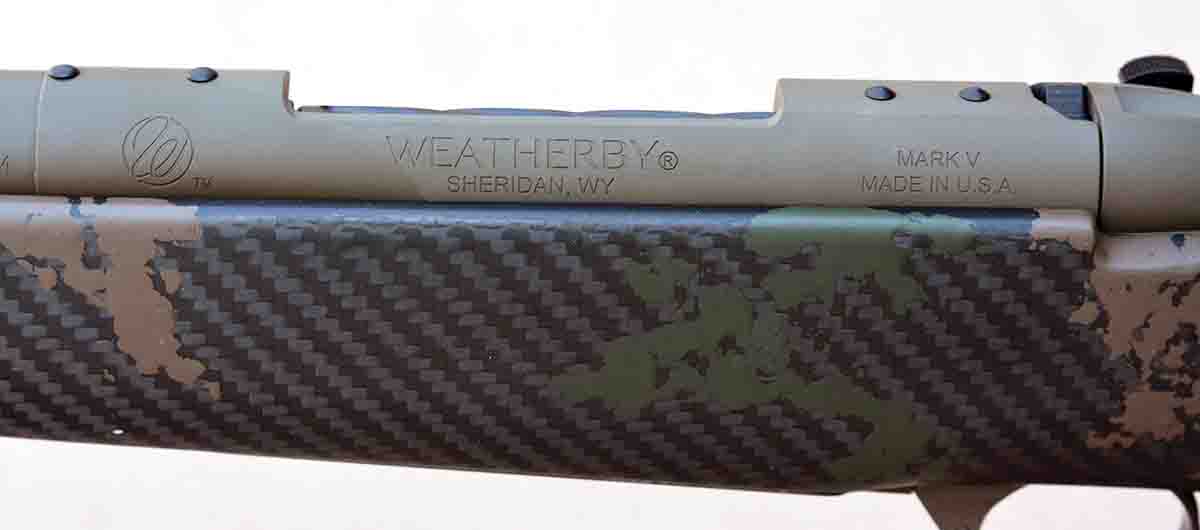
The Mark V Backcountry 2.0 action features a push-feed action, with a countersunk bolt face, plunger ejector and rotating extractor. The bolt lift is 54 degrees; the bolt handle is swept, while the bolt knob is slotted, lightweight and threaded to allow interchangeable knobs for customization to best fit a variety of applications. The bolt body is deeply spiral fluted that serves to reduce weight and friction while cycling the action. The bottom metal is a one-piece alloy with a hinged floorplate. The magazine capacity is three rounds, plus one in the chamber. The safety is two-position (located to the right side of the bolt cap) and locks the bolt closed when in the “ON” position. The trigger is manufactured by TriggerTech, which broke very crisp at 3 pounds right out of the box and had virtually no creep, practically no aftertravel and is fully adjustable in 1-ounce increments. The barrel is 18 inches, fluted and threaded to accommodate a variety of accessories, but is also offered in 20- and 24-inch versions. The metal is coated with CERAKOTE, which is a ceramic that offers corrosion resistance and resists wear. The stock is sourced from Peak 44, which is classic-styled with a high comb position and is constructed of ultra-lightweight carbon fiber with a combination of glass bedding in the recoil lug area and twin aluminum pillar bedding blocks. A lightweight 3DHEX buttpad is standard. The barrel is fully free-floating. Without accessories, the rifle weighs 86.1 ounces, or 5.38 pounds and it is available in right- or left-hand versions.
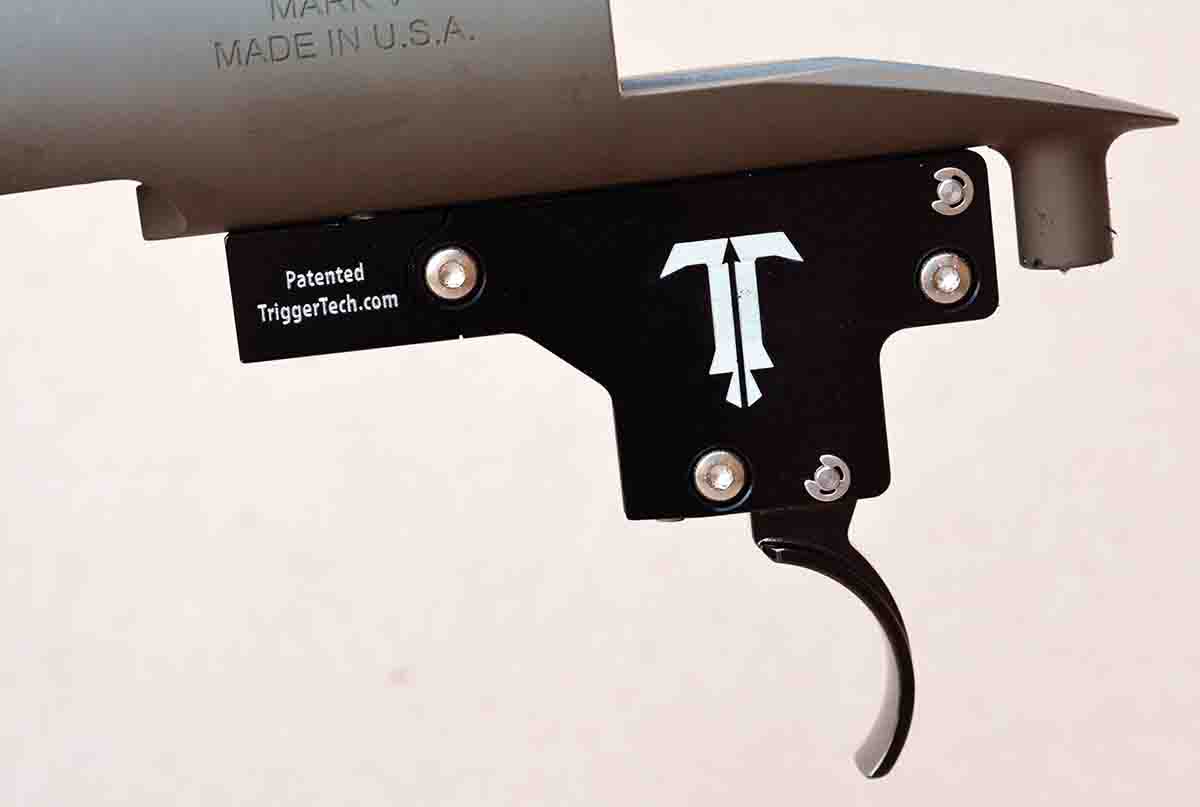
As indicated, I was sent a Mark V Backcountry 2.0 fitted with an 18-inch threaded barrel to evaluate the 338 RPM. This is a most interesting rifle, as it is lightweight and compact, as well as potent and accurate. For instance, the overall rifle length is just a shade over 38 inches, which is similar to the famous Winchester Model 1894 saddle ring carbine that is praised for its short, trim profile and fast-handling characteristics. Due to its compact, fast-handling length, this rifle will prove to be especially handy in brush and timber, but it is nonetheless very capable of making long shots in open country. Incidentally, Weatherby guarantees sub-MOA accuracy at 100 yards when using Weatherby premium ammunition.
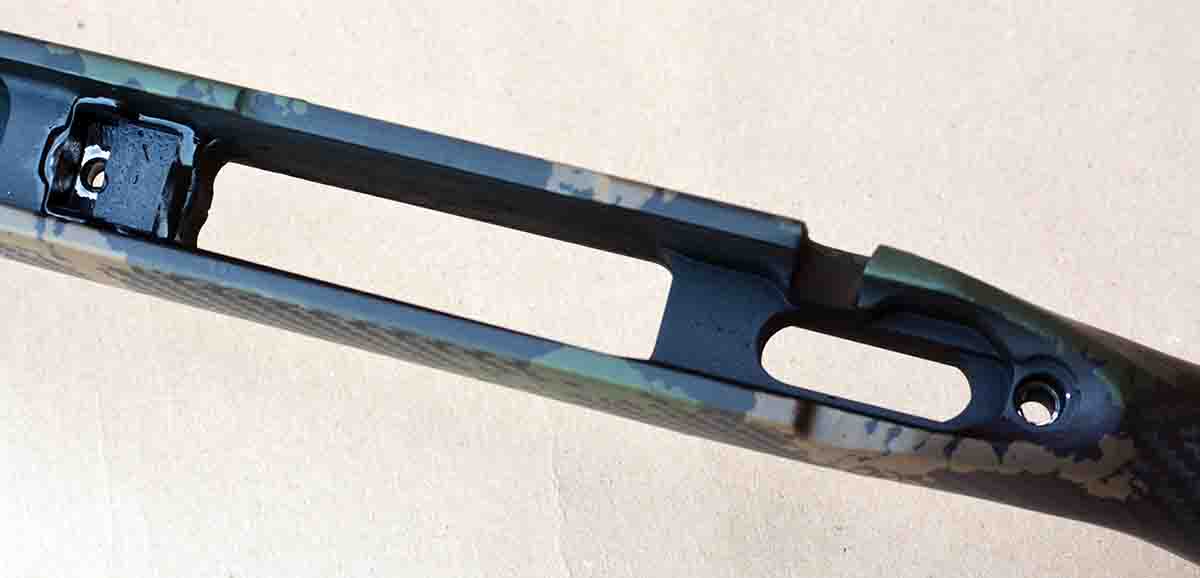
A lower power variable scope was ordered, but did not arrive in time to be used. So a Leupold VX-3i LRP 6.5-20x 50mm scope with Front Focal Plane with TMR reticle was installed using QRW rings. Frankly, this scope is larger and heavier than what this compact, lightweight hunting rifle will best be mated to. However, for testing the rifle and cartridge, it is an excellent choice, with outstanding optics, positive adjustments, outstanding reliability and it offers the many great features we have come to expect from Leupold.
As indicated, the only factory load available at press time was the Barnes 185-grain TTSX, which clocked 2,872 fps from the 18-inch barrel. Weatherby claims 3,100 fps from a 24-inch barrel, but lists velocity at 2,860 fps from an 18-inch barrel (see table); their listed velocities are very close. For a five-shot string, the extreme spread was 24 fps. Incidentally, factory loads contained 71.1 grains of spherical powder.
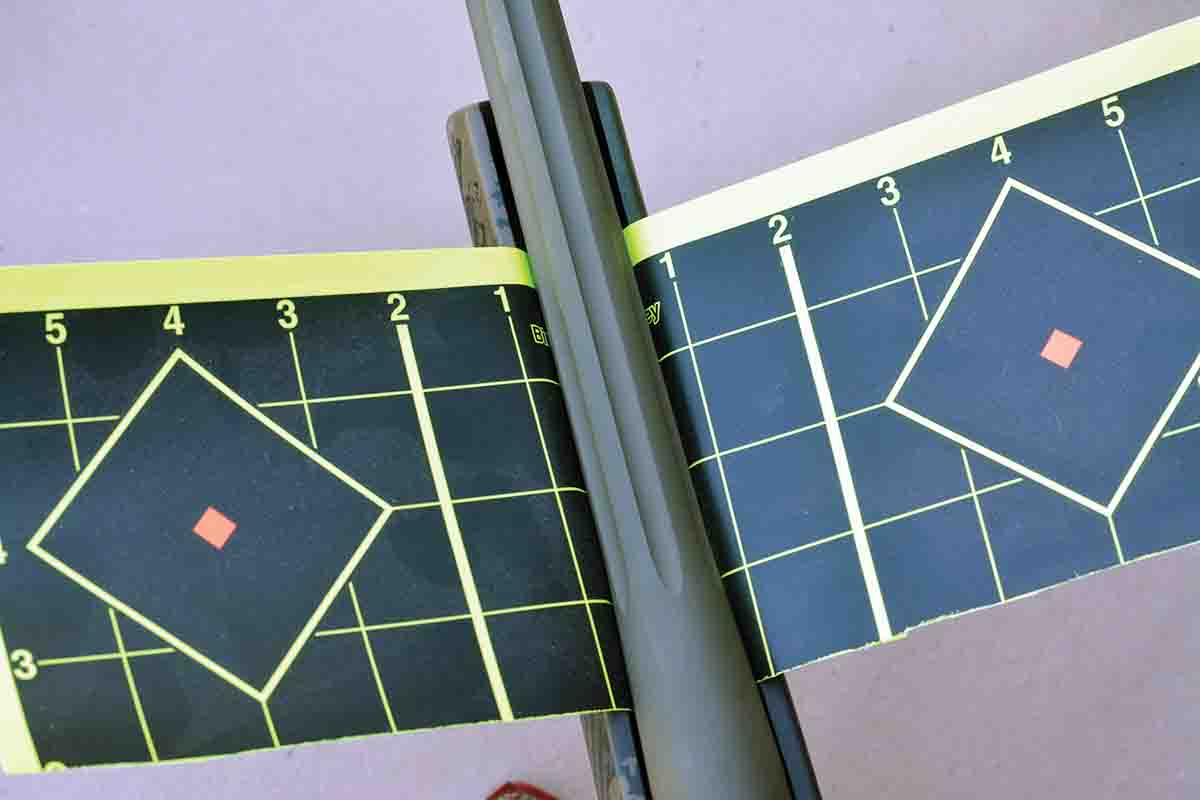
For the first 21 rounds, the barrel was cleaned after every three shots, followed by very light traces of synthetic oil being wiped in the bore. At this point, the rifle was checked for accuracy. Five groups consisting of three shots each, produced from .62- to .89-inch groups, with the average being just less than .70 inch.
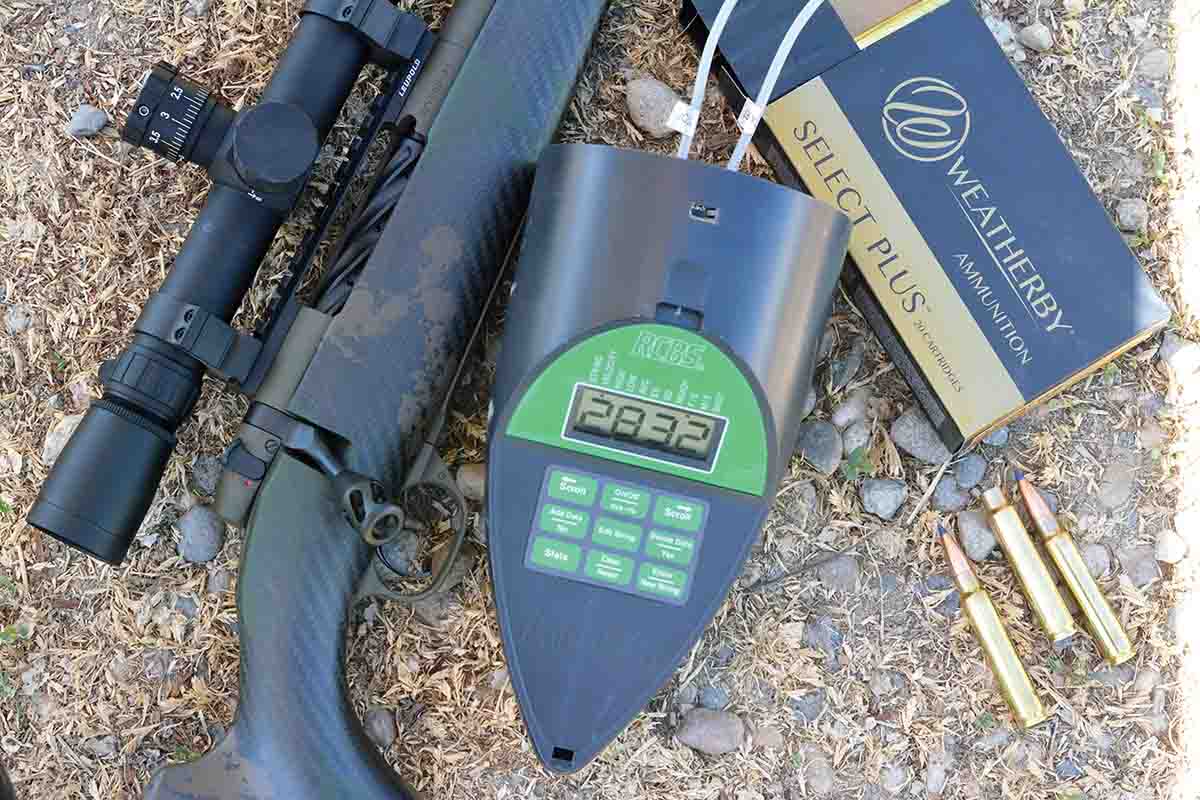
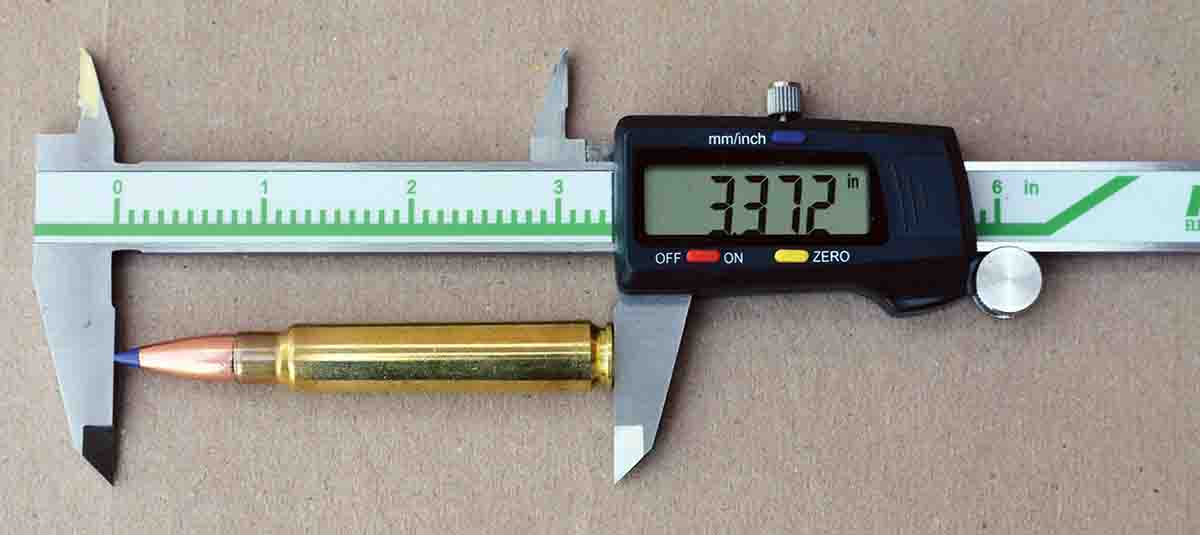
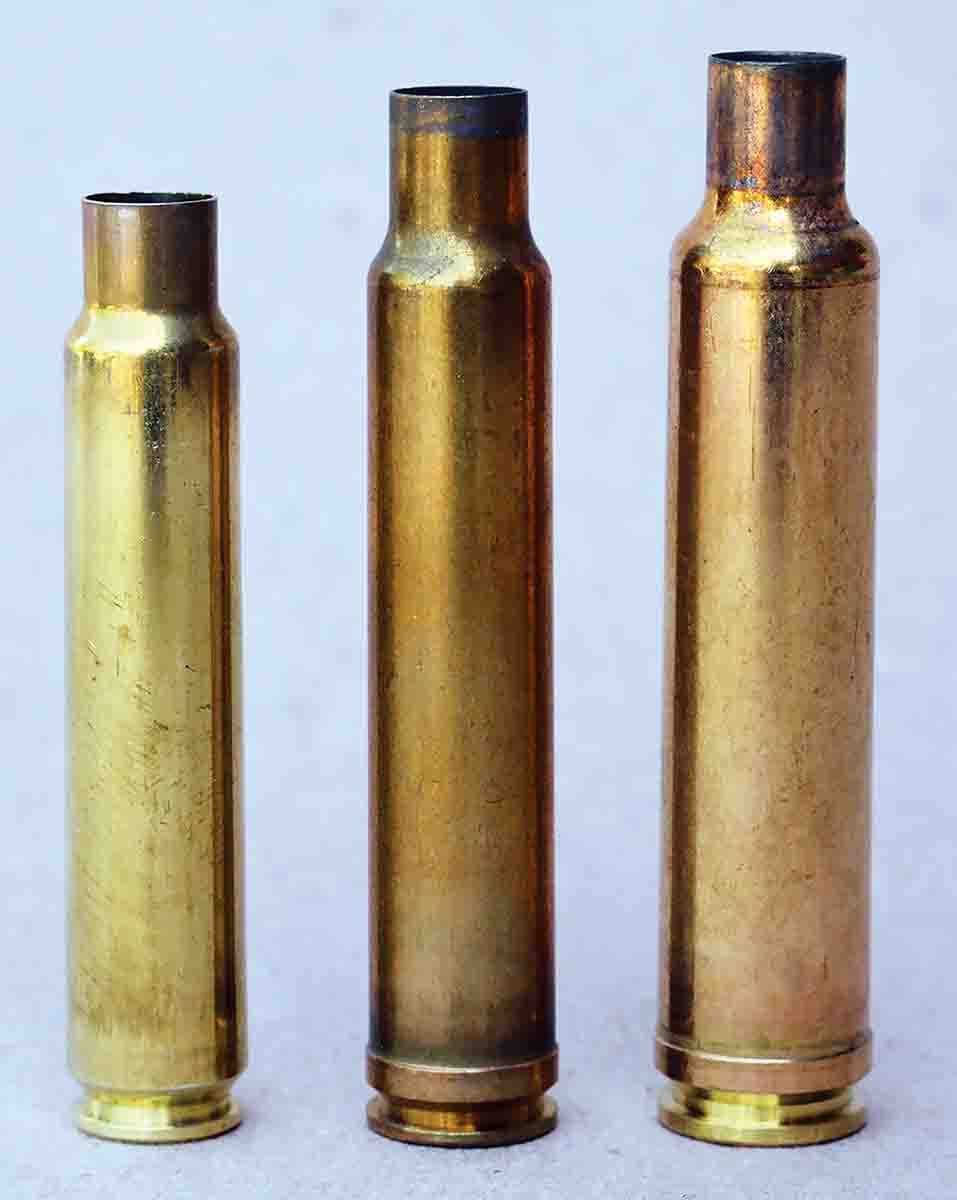
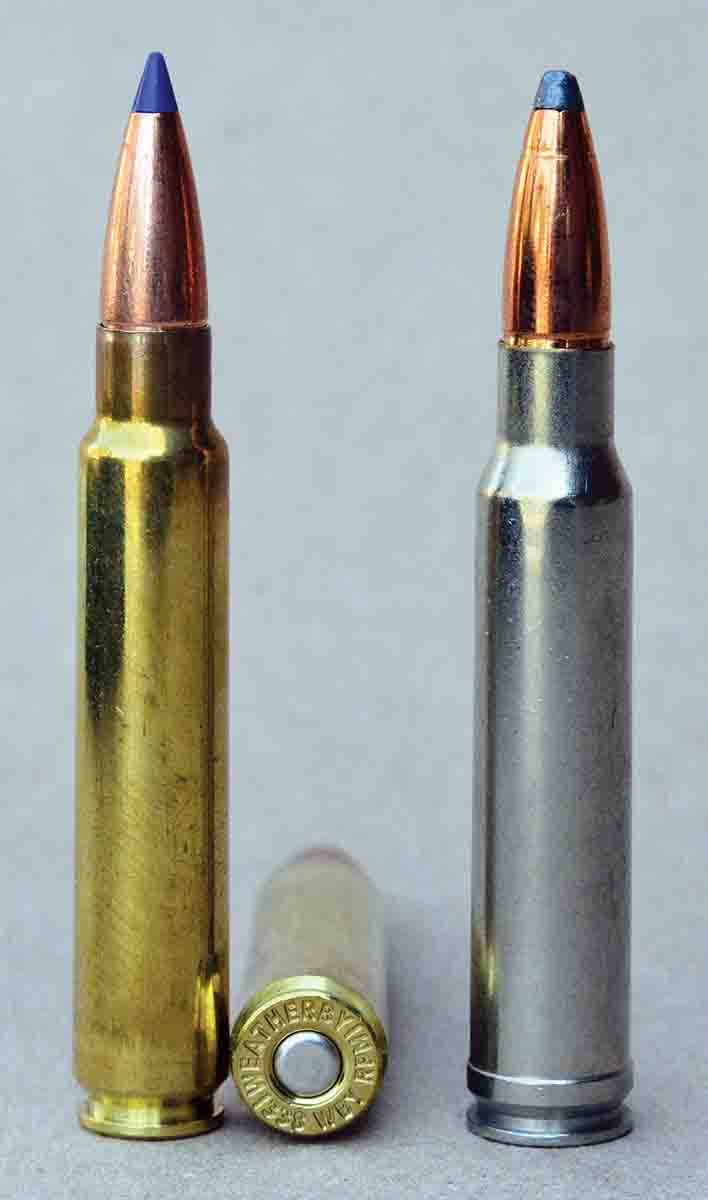
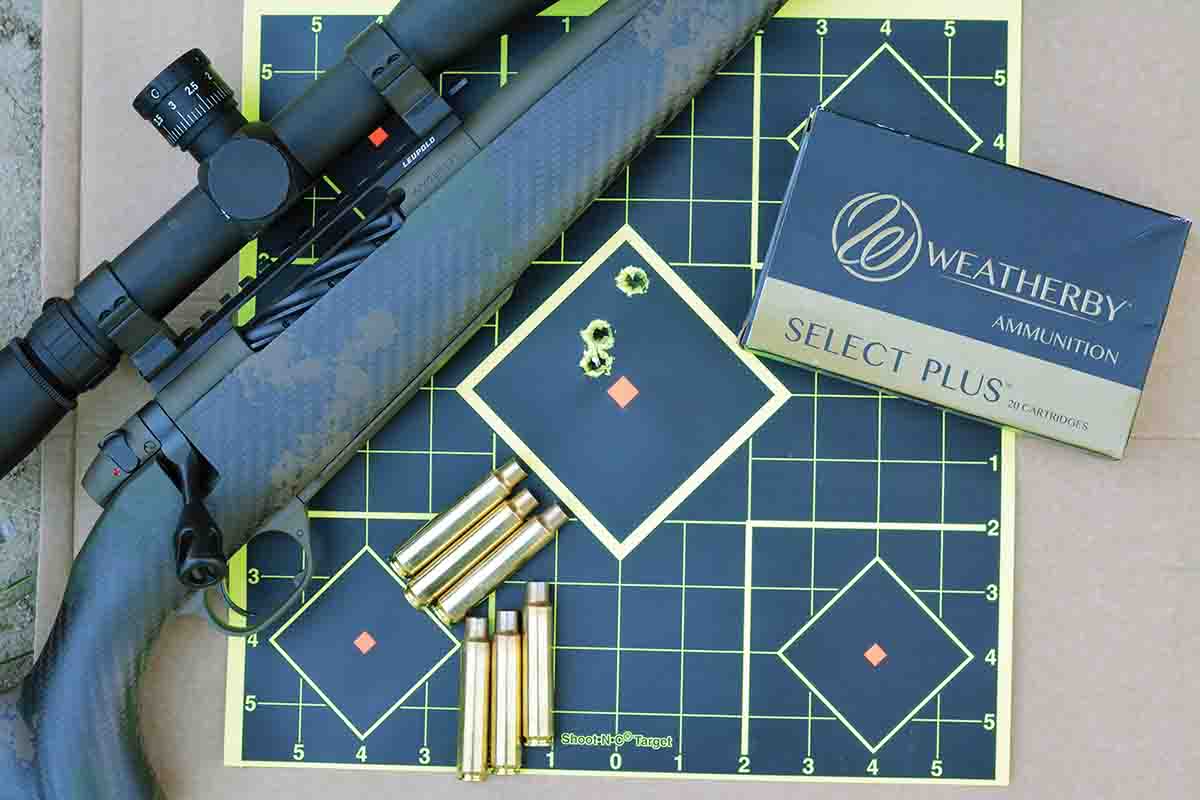
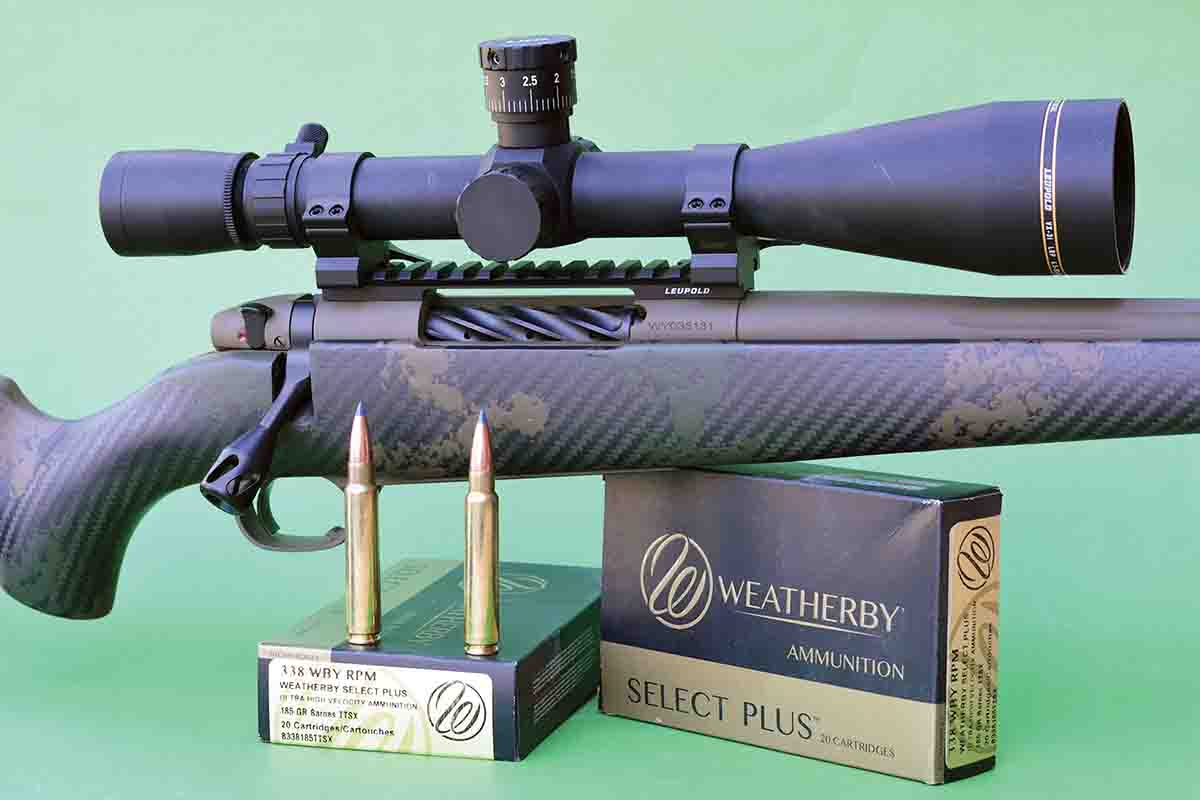
.jpg)
.jpg)


